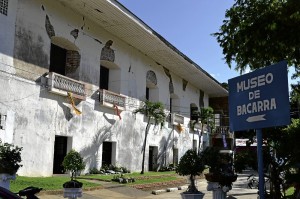Museum hopes to put Ilocos town on tourism map
BACARRA, Ilocos Norte—A bucolic town north of Laoag City, Bacarra, has been largely ignored by tourists on their way to to the more popular attractions in the province’s northern section because its town center is out of the usual road map.
Unless the trip is prearranged, motorists would be missing the town’s “ground zero,” where the locals’ pride, the Bacarra belfry ruins, stands.
But this third class town (average annual income: P35-P45 million), locally known as a “balikbayan town” (it was second after Makati City in having the most overseas Filipino workers in the 1970s, according to town records), has more to offer than its crownless bell tower and rustic surroundings.
A cursory trip to the town would show dozens of medium to large concrete houses, a testament of Bacarra as home to most “Hawaiianos,” a reference to Ilocanos living in Hawaii and other parts of the United States.
Near the tower and next to Bacarra Church is a museum of religious and cultural artifacts housed inside the restored St. Andrew the Apostle convent. The once abandoned two-story convent was given a facelift with funds from the National Commission for Culture and the Arts.
Article continues after this advertisementMuseo de Bacarra opened early this month more than a year after it started collecting artifacts donated by residents.
Article continues after this advertisementAscencion Bonoan, vice chair of the town’s tourism and development council, said tourists looking for a fresh glimpse of Ilocano history and interesting remnants of religious beginnings are trickling in.
He said Spaniards once referred to Bacarra as the “Vatican of the Philippines” because many of its men embraced priesthood.
A section of Museo de Bacarra is devoted to the town’s religious icons and church relics, including baptismal archives that date back to 1702.
Bonoan, who was born and raised in Bacarra, said powerful earthquakes sculpted the town’s bell tower to what would later become a cultural landmark.
He said the three-tiered bell tower stood proudly since 1828. Periodic earthquakes caused its dome to lean starting in 1931. It crumbled further when another quake struck in 1971.
The dead dictator Ferdinand Marcos recognized the tower’s cultural value and declared it a national cultural treasure through Presidential Decree No. 260 in 1973.
The tower’s dome finally fell off its crown after a 6.5-magnitude earthquake struck Laoag in August 1983. Remnants of the tower’s coral brick facade remain embedded on the ground beside the belfry ruins.
Adding mystery to the museum is an underground staircase found behind the old convent and known to locals as the “secret garden.” At the bottom of the brick staircase are three tunnels, which old Spanish records said lead separately to Bacarra River, the tower and the church altar.
